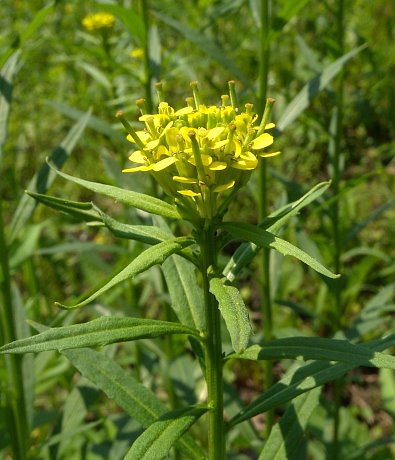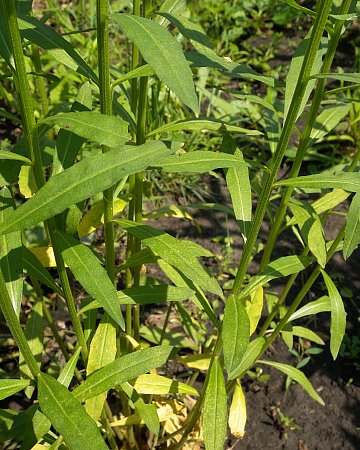
The central stem terminates in a narrow raceme of flowers about ¼-1' long. In addition, upper lateral stems may terminate in smaller racemes. The flowers bloom at the apex of each raceme, while developing seedpods are located below. Each flower is about ¼" across, consisting of 4 pale yellow to yellow petals, 4 pale green sepals, 6 stamens, and a pistil with a single style. The petals are oblanceolate in shape, while the sepals are narrowly oblong. Individual petals of each flower are 3.0-5.5 mm. in length, while individual sepals are 2.0-3.0 mm. in length. Often, the flowers are partially hidden by the developing seedpods. The blooming period occurs from late spring to late summer, lasting 1-2
Cultivation: Wormseed Mustard prefers full sun, moist to mesic conditions, and a fertile loamy soil.
Range & Habitat: The non-native Wormseed Mustard is occasional in the northern half of Illinois, while in the southern half of the state it is rare or absent. This weedy plant was introduced into Illinois from either western North America or Eurasia (different sources don't always agree regarding its place of origination). It is possible that this plant is more common than current records indicate. Habitats include barnyards, pastures, low areas along ditches, roadsides and areas along railroads, garden beds, and waste areas. Open disturbed areas are strongly preferred.
Faunal Associations: Like similar species in the Mustard family, the flowers of Wormseed Mustard are cross-pollinated primarily by small bees and flies. Floral rewards of these insect visitors consist of nectar and pollen. Several beetles in the Chrysomelidae (Leaf Beetles) feed on Wormseed Mustard. They include Entomoscelis americana (Red Turnip Beetle), Phyllotreta cruciferae (Crucifer Flea Beetle), Phyllotreta striolata (Striped Flea Beetle), and Psylliodes punctulatus (Hop Flea Beetle, Cabbage Stem Flea Beetle). According to Georgia (1913), the foliage of Wormseed Mustard and especially its seeds are very bitter. As a result, grazing animals dislike this plant, although they may eat it if little else is available.
Photographic Location: A dried-out ditch near Weaver Park in Urbana, Illinois.

Comments: The flowers of this weedy plant are quite small. The common name refers to the former use of its seeds as an anthelmintic (expeller of worms in the digestive tract). Wormseed Mustard differs from many other species in the Mustard family by its narrow leaves, which lack lobes and significant teeth. The species that most resembles it within Illinois, Erysimum inconspicuum (Small Wormseed Mustard), is a perennial that is adventive from the Western states. This latter species has flowers with larger petals (exceeding 6.0 mm. in length) and larger sepals (exceeding 3.5 mm. in length) than Wormseed Mustard. It also tends to be shorter and prefers drier situations.